Unit 7 Food festival Topic 2 I’m not sure whether I can cook it well. Section D课件(共27张PPT)
文档属性
| 名称 | Unit 7 Food festival Topic 2 I’m not sure whether I can cook it well. Section D课件(共27张PPT) | 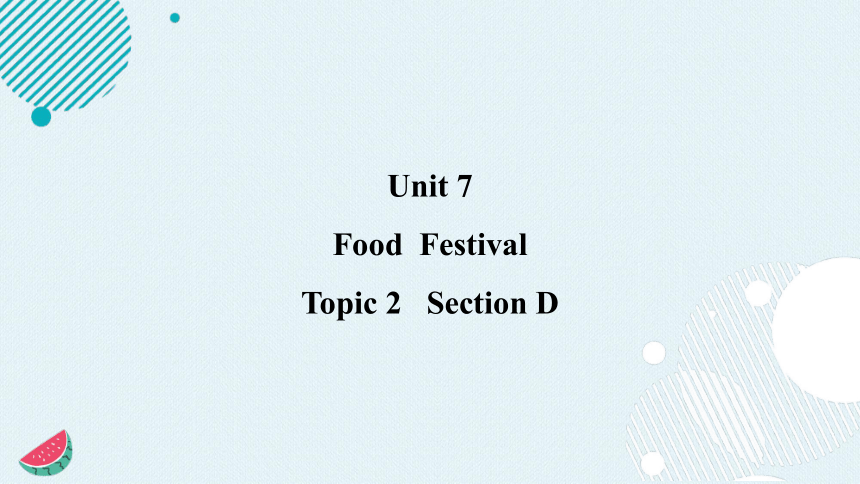 | |
| 格式 | pptx | ||
| 文件大小 | 2.8MB | ||
| 资源类型 | 教案 | ||
| 版本资源 | 仁爱科普版 | ||
| 科目 | 英语 | ||
| 更新时间 | 2024-11-24 04:26:03 | ||
图片预览


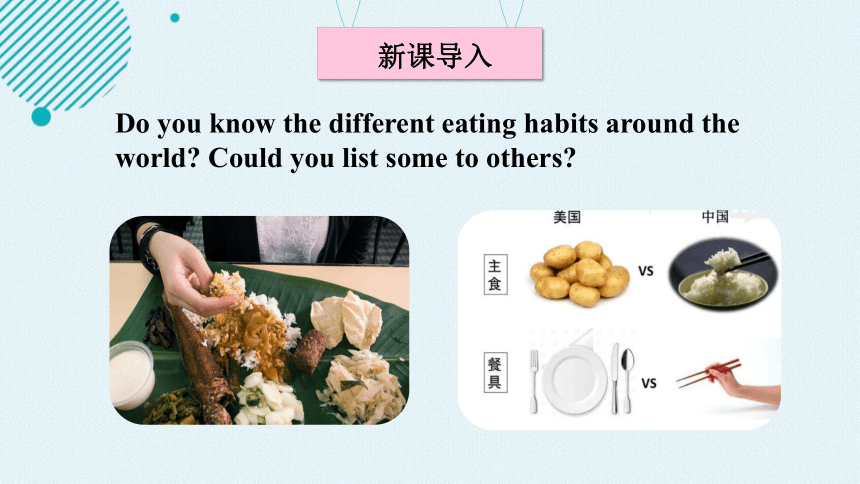
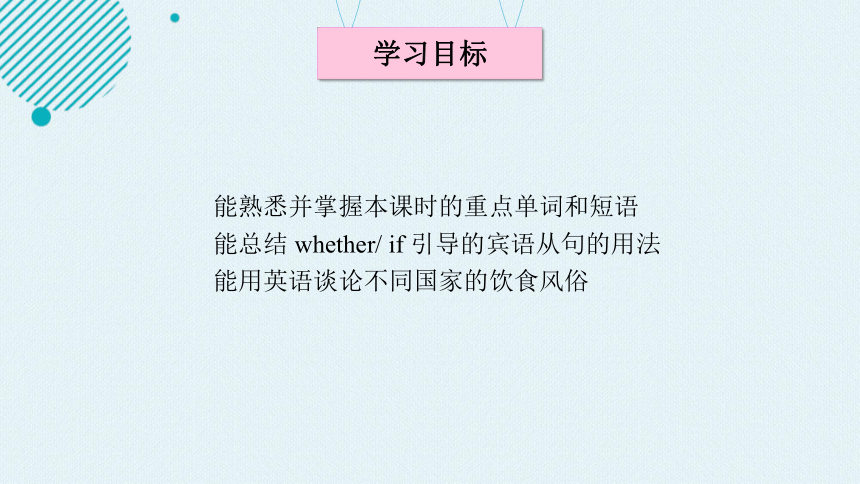

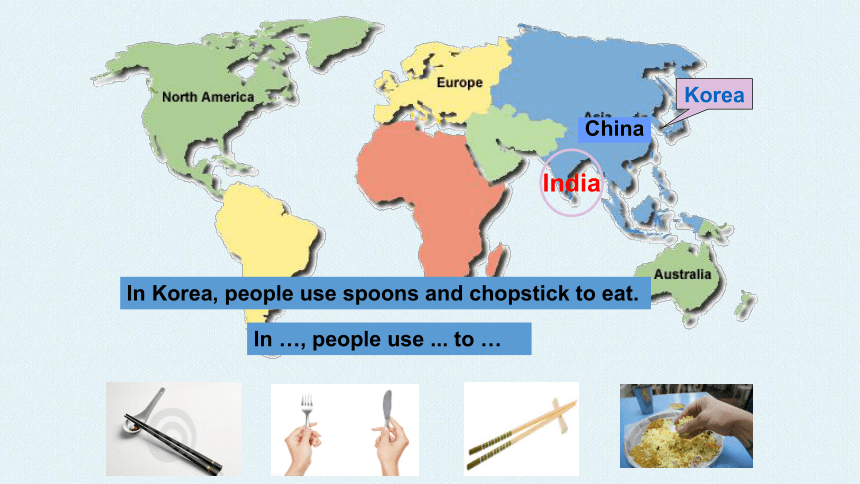
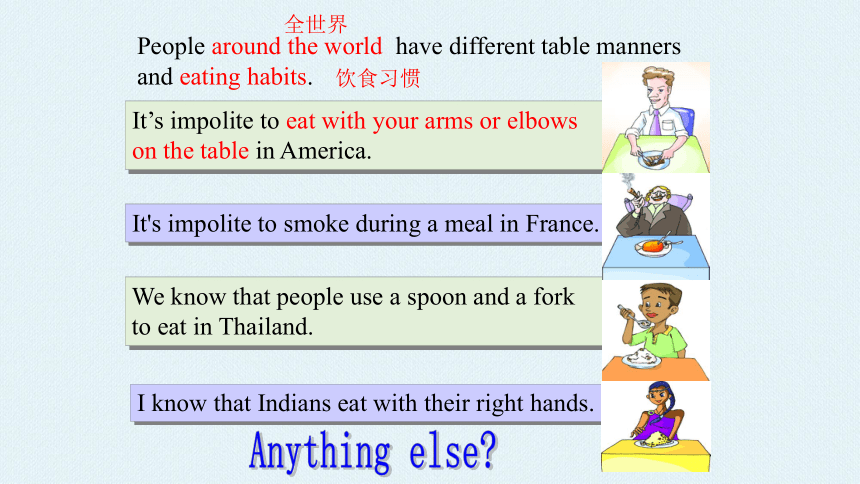

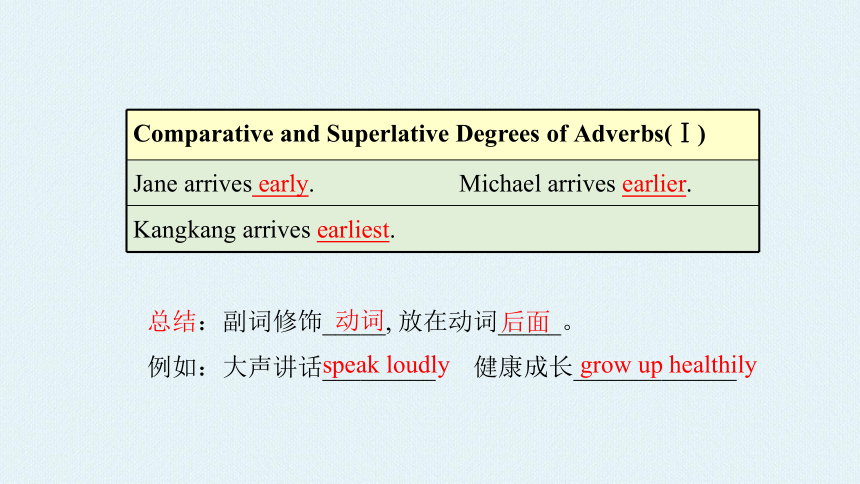
文档简介
(共27张PPT)
Unit 7
Food Festival
Topic 2 Section D
学习目标
重点探究
自主学习
学习导航
当堂检测
课堂总结
拓展提升
新课导入
Do you know the different eating habits around the world Could you list some to others
学习目标
能熟悉并掌握本课时的重点单词和短语
能总结 whether/ if 引导的宾语从句的用法
能用英语谈论不同国家的饮食风俗
自主学习
southern adj. 南方的,南部的
seafood n. 海鲜,海味
pick v. 采,摘;拾起,采集;挑选
pick up 捡起;获得;收拾
sausage n. 香肠
Korea
India
China
In Korea, people use spoons and chopstick to eat.
In …, people use ... to …
It’s impolite to eat with your arms or elbows on the table in America.
It's impolite to smoke during a meal in France.
We know that people use a spoon and a fork to eat in Thailand.
I know that Indians eat with their right hands.
People around the world have different table manners and eating habits.
全世界
饮食习惯
Anything else
重点探究
Object Clauses(Ⅱ)
But I'm not sure whether/if I can cook it well.
Can you tell me if/whether it's polite to eat with your arms or elbows on the table in America
Do you know whether or not it's impolite to smoke during a meal in France
Grammar
总结:if /whether 引导宾语从句时,翻译为“_____”,通常两者可以_________,但是当与or not 搭配时,只能用_______。if / whether 引导的宾语从句通常表达一般疑问的意思。
是否
互相替换
whether
Comparative and Superlative Degrees of Adverbs(Ⅰ)
Jane arrives early. Michael arrives earlier.
Kangkang arrives earliest.
总结:副词修饰_____, 放在动词_____。
例如:大声讲话_________ 健康成长_____________
动词
speak loudly
grow up healthily
后面
First ... Second ... Next ... Then ... After that ... Finally ...
Well done!
Would you mind if we learn to make it from you
Of course not.
Remember not to drink too much.
Functions
Eating Habits
People around the world have different eating habits.
In North America, Australia and Europe, there are two or more courses for every meal and people use knives and forks to eat.
In the southern part of China, people eat rice a lot, while in the north people often eat noodles. In the central and western parts, people are far away from the sea, so they don’t eat much seafood. But all Chinese people use chopsticks to eat.
1 Read the passage and underline the different
eating tasks in different areas. Then retell the
passage and share it with the whole class.
In parts of India, people use their fingers to pick up the food.
In Thailand,people eat with a spoon and a fork and they don't use knives at all.
In Korea, people use spoons or chopsticks to eat, but it is not polite to use both of them at the same time.
1. Can you tell my if there is only one course for every meal in North America, Australia and Europe
2. Do you know if people in southern part of China often eat noodles
No. There are two or more courses for every meal.
No. In the southern part of China, people eat rice a lot, while in the north people often eat noodles.
Read 1 and answer the questions.
3. Can you tell me whether people eat much seafood in the central and western parts of China
4. Do you know whether people use spoons and chopsticks at the same time in Korea
No, I don’t think so. It is not polite.
No. They are far away from the sea.
Fill in the table according to 1a.
Area Eating habits
North America / Australia / Europe
China
Parts of India
Thailand
Korea
There are two or more courses for every meal and people use knives and forks to eat.
All Chinese people use chopsticks to eat.
People use their fingers to pick up the food.
People use spoons or chopsticks to eat, but it is not polite to use both of them at the same time.
People eat with a spoon and a fork and they don't use knives at all.
1. different eating habits
2. North America, Australia, Europe, courses , knives, 3. southern part of China, rice, north, noodles, central, western, don’t, seafood, chopsticks.
4. parts of India, fingers, pick up.
5. Thailand, spoon,fork, don't use knives.
6. Korea, spoons, chopsticks, not polite, both.
Retell the passage with the help of key words.
Beth Tom
Is the most popular food in your restaurant hot dogs Yes, it is.
Are the sausages in your hot dogs different from those in others Yes, they are.
Are dumplings your favorite Chinese food No, they aren't.
Do you like Chinese food No, not at all.
2 Suppose you are Beth. Report the following
interview notes to your partner.
Example:
I ask Tom if/whether the most popular food in his restaurant is hot dogs.And he says it is.
Pair Work
I ask Tom if/whether the sausages in your hot dogs are different from those in others. And he says they are.
I ask Tom if/whether dumplings are his favorite Chinese food And he says they aren’t.
I ask Tom if/whether he likes Chinese food. And he says he does not like it at all.
cut up
wash
put...into
boil
add salt,
green onions
ready,
enjoy
3 Look at the pictures and write a passage about
how to cook chicken soup.
First, cut up the chicken. Second, wash it. Next, put it into the pot. Then, boil it . After that, add the salt and green onions. Finally, it’s ready and enjoy it.
Example:
Chicken soup is very delicious, and it’s good for our health. Would you like to eat some chicken soup Well, let’s cook it together.
First, cut up chicken. Next, wash the chicken and put it into a deep pot 70% -80% full of water. Then, boil the chicken for about 2 hours. Finally, add some salt, green onions and so on. Now the chicken soup is ready and you can enjoy it.
I can cook, but Tom can cook _____ than me. His mother cooks the ______. One day I ask Tom _________ can cook the chicken soup. And he says _____ he can. And he told me ____ the way of cooking it. _____, cut up the chicken._______, wash it. _____, put it into the pot. ______, boil it. _________, add the salt and green onions. _______, it’s ready and enjoy it.
better
best
if/whether
that
that
First
Second
Next
Then
After that
Finally
Expand this passage by using the object clause and
comparative and superlative degrees of adverbs.
Table Manners in Different Countries
Prepare some hats with country names, such as Japan and Cuba on them.
The students wearing the hats will do some eating actions.The other students guess and discuss.
What’s he / she doing
Is it polite to do this during dinner in Japan / Cuba ...
Is it polite to put arms or elbows on the table in Japan / Cuba ...
3. Write a passage about table manners in different countries.
Language points
拓展提升
1. In North America, Australia and Europe, there are two
or more courses for every meal and people use knives
and forks to eat.
在北美、澳大利亚和欧洲,每顿饭都有两道或更多
的菜肴。人们用刀叉吃饭。
1 )two or more courses 两道或更多的菜肴;two or
three 两三个;
2 )course “ 菜肴” ,它还有“ 课程” 的意思。
e.g. I’m in Grade Eight, and now I have thirteen courses.
我现在读八年级,有 13 门课程。
2. In the central and western parts, people are far away from
the sea, so they don’t eat much seafood.
在中国中西部地区,人们离海洋很远,因此他们没有
吃太多的海鲜。
1)此句中 central 和western 都是形容词,是由 centre
去e+al 和west +ern 构成的形容词。
e.g. medic( 医生) 加 al→medical (医学的) north ( 北
部) 加 ern →northern ( 北部的)
2 )be far away from 远离……;
My home is very far from the hospital. 我家离医院很远。
3. In parts of India, they use their fingers to pick up the food .
在印度地区,他们用手指来抓食物。
pick up a) 拾起,捡起;
e.g. She picked up a stone and threw it at the window.
她捡起一块石头朝窗户扔去。
b) (车、船等)搭载客人,驾车去迎接(某人),
在途中搭载,装载(货物,行李等);
e.g. I’ll pick you up at your place at 8 o’clock.
8 点钟我来你住的地方接你。
c) 接收,收到;
e.g. My radio can pick up BBC English.
我的收音机能接收 BBC 英语节目。
当堂检测
1. —Where is Shenzhen
—It's in the _________(南方的) of China.
2. —Would you like to _______(拾起) these paper for me
—Of course.
3. My home is ____________(远离) the school and I have
to take the bus to school every day.
4.— How do the Indians eat
— I heard they eat _______________(用手指).
5. In our class, Kangkang arrives _______(最早) of all.
southern
pick up
far away from
with their fingers
earliest
一、根据中文意思填空。
课堂总结
Unit 7 Topic 2
Section D
重点单词和短语:
southern, seafood, pick, eating habits, in the southern part of, pick up, at the same time
不同地区的饮食习惯:
不同地区的饮食习惯是1._______,在北美地区,人们通常使用2.____ 和3._____ 等这样的餐具,在4._______ 部分地区, 人们用直接用手吃饭。
if/whether引导的宾语从句和表示先后顺序的副词以及副词比较级、最高级:
不同的
刀
叉
印度
Unit 7
Food Festival
Topic 2 Section D
学习目标
重点探究
自主学习
学习导航
当堂检测
课堂总结
拓展提升
新课导入
Do you know the different eating habits around the world Could you list some to others
学习目标
能熟悉并掌握本课时的重点单词和短语
能总结 whether/ if 引导的宾语从句的用法
能用英语谈论不同国家的饮食风俗
自主学习
southern adj. 南方的,南部的
seafood n. 海鲜,海味
pick v. 采,摘;拾起,采集;挑选
pick up 捡起;获得;收拾
sausage n. 香肠
Korea
India
China
In Korea, people use spoons and chopstick to eat.
In …, people use ... to …
It’s impolite to eat with your arms or elbows on the table in America.
It's impolite to smoke during a meal in France.
We know that people use a spoon and a fork to eat in Thailand.
I know that Indians eat with their right hands.
People around the world have different table manners and eating habits.
全世界
饮食习惯
Anything else
重点探究
Object Clauses(Ⅱ)
But I'm not sure whether/if I can cook it well.
Can you tell me if/whether it's polite to eat with your arms or elbows on the table in America
Do you know whether or not it's impolite to smoke during a meal in France
Grammar
总结:if /whether 引导宾语从句时,翻译为“_____”,通常两者可以_________,但是当与or not 搭配时,只能用_______。if / whether 引导的宾语从句通常表达一般疑问的意思。
是否
互相替换
whether
Comparative and Superlative Degrees of Adverbs(Ⅰ)
Jane arrives early. Michael arrives earlier.
Kangkang arrives earliest.
总结:副词修饰_____, 放在动词_____。
例如:大声讲话_________ 健康成长_____________
动词
speak loudly
grow up healthily
后面
First ... Second ... Next ... Then ... After that ... Finally ...
Well done!
Would you mind if we learn to make it from you
Of course not.
Remember not to drink too much.
Functions
Eating Habits
People around the world have different eating habits.
In North America, Australia and Europe, there are two or more courses for every meal and people use knives and forks to eat.
In the southern part of China, people eat rice a lot, while in the north people often eat noodles. In the central and western parts, people are far away from the sea, so they don’t eat much seafood. But all Chinese people use chopsticks to eat.
1 Read the passage and underline the different
eating tasks in different areas. Then retell the
passage and share it with the whole class.
In parts of India, people use their fingers to pick up the food.
In Thailand,people eat with a spoon and a fork and they don't use knives at all.
In Korea, people use spoons or chopsticks to eat, but it is not polite to use both of them at the same time.
1. Can you tell my if there is only one course for every meal in North America, Australia and Europe
2. Do you know if people in southern part of China often eat noodles
No. There are two or more courses for every meal.
No. In the southern part of China, people eat rice a lot, while in the north people often eat noodles.
Read 1 and answer the questions.
3. Can you tell me whether people eat much seafood in the central and western parts of China
4. Do you know whether people use spoons and chopsticks at the same time in Korea
No, I don’t think so. It is not polite.
No. They are far away from the sea.
Fill in the table according to 1a.
Area Eating habits
North America / Australia / Europe
China
Parts of India
Thailand
Korea
There are two or more courses for every meal and people use knives and forks to eat.
All Chinese people use chopsticks to eat.
People use their fingers to pick up the food.
People use spoons or chopsticks to eat, but it is not polite to use both of them at the same time.
People eat with a spoon and a fork and they don't use knives at all.
1. different eating habits
2. North America, Australia, Europe, courses , knives, 3. southern part of China, rice, north, noodles, central, western, don’t, seafood, chopsticks.
4. parts of India, fingers, pick up.
5. Thailand, spoon,fork, don't use knives.
6. Korea, spoons, chopsticks, not polite, both.
Retell the passage with the help of key words.
Beth Tom
Is the most popular food in your restaurant hot dogs Yes, it is.
Are the sausages in your hot dogs different from those in others Yes, they are.
Are dumplings your favorite Chinese food No, they aren't.
Do you like Chinese food No, not at all.
2 Suppose you are Beth. Report the following
interview notes to your partner.
Example:
I ask Tom if/whether the most popular food in his restaurant is hot dogs.And he says it is.
Pair Work
I ask Tom if/whether the sausages in your hot dogs are different from those in others. And he says they are.
I ask Tom if/whether dumplings are his favorite Chinese food And he says they aren’t.
I ask Tom if/whether he likes Chinese food. And he says he does not like it at all.
cut up
wash
put...into
boil
add salt,
green onions
ready,
enjoy
3 Look at the pictures and write a passage about
how to cook chicken soup.
First, cut up the chicken. Second, wash it. Next, put it into the pot. Then, boil it . After that, add the salt and green onions. Finally, it’s ready and enjoy it.
Example:
Chicken soup is very delicious, and it’s good for our health. Would you like to eat some chicken soup Well, let’s cook it together.
First, cut up chicken. Next, wash the chicken and put it into a deep pot 70% -80% full of water. Then, boil the chicken for about 2 hours. Finally, add some salt, green onions and so on. Now the chicken soup is ready and you can enjoy it.
I can cook, but Tom can cook _____ than me. His mother cooks the ______. One day I ask Tom _________ can cook the chicken soup. And he says _____ he can. And he told me ____ the way of cooking it. _____, cut up the chicken._______, wash it. _____, put it into the pot. ______, boil it. _________, add the salt and green onions. _______, it’s ready and enjoy it.
better
best
if/whether
that
that
First
Second
Next
Then
After that
Finally
Expand this passage by using the object clause and
comparative and superlative degrees of adverbs.
Table Manners in Different Countries
Prepare some hats with country names, such as Japan and Cuba on them.
The students wearing the hats will do some eating actions.The other students guess and discuss.
What’s he / she doing
Is it polite to do this during dinner in Japan / Cuba ...
Is it polite to put arms or elbows on the table in Japan / Cuba ...
3. Write a passage about table manners in different countries.
Language points
拓展提升
1. In North America, Australia and Europe, there are two
or more courses for every meal and people use knives
and forks to eat.
在北美、澳大利亚和欧洲,每顿饭都有两道或更多
的菜肴。人们用刀叉吃饭。
1 )two or more courses 两道或更多的菜肴;two or
three 两三个;
2 )course “ 菜肴” ,它还有“ 课程” 的意思。
e.g. I’m in Grade Eight, and now I have thirteen courses.
我现在读八年级,有 13 门课程。
2. In the central and western parts, people are far away from
the sea, so they don’t eat much seafood.
在中国中西部地区,人们离海洋很远,因此他们没有
吃太多的海鲜。
1)此句中 central 和western 都是形容词,是由 centre
去e+al 和west +ern 构成的形容词。
e.g. medic( 医生) 加 al→medical (医学的) north ( 北
部) 加 ern →northern ( 北部的)
2 )be far away from 远离……;
My home is very far from the hospital. 我家离医院很远。
3. In parts of India, they use their fingers to pick up the food .
在印度地区,他们用手指来抓食物。
pick up a) 拾起,捡起;
e.g. She picked up a stone and threw it at the window.
她捡起一块石头朝窗户扔去。
b) (车、船等)搭载客人,驾车去迎接(某人),
在途中搭载,装载(货物,行李等);
e.g. I’ll pick you up at your place at 8 o’clock.
8 点钟我来你住的地方接你。
c) 接收,收到;
e.g. My radio can pick up BBC English.
我的收音机能接收 BBC 英语节目。
当堂检测
1. —Where is Shenzhen
—It's in the _________(南方的) of China.
2. —Would you like to _______(拾起) these paper for me
—Of course.
3. My home is ____________(远离) the school and I have
to take the bus to school every day.
4.— How do the Indians eat
— I heard they eat _______________(用手指).
5. In our class, Kangkang arrives _______(最早) of all.
southern
pick up
far away from
with their fingers
earliest
一、根据中文意思填空。
课堂总结
Unit 7 Topic 2
Section D
重点单词和短语:
southern, seafood, pick, eating habits, in the southern part of, pick up, at the same time
不同地区的饮食习惯:
不同地区的饮食习惯是1._______,在北美地区,人们通常使用2.____ 和3._____ 等这样的餐具,在4._______ 部分地区, 人们用直接用手吃饭。
if/whether引导的宾语从句和表示先后顺序的副词以及副词比较级、最高级:
不同的
刀
叉
印度
同课章节目录
- Unit 5 Feeling excited
- Topic 1 You look excited
- Topic 2 I’m feeling better now.
- Topic 3 Many things can affect our feelings.
- Unit 6 Enjoying Cycling
- Topic 1 We're going on a three-day visit to Mount
- Topic 2 How about exploring Tian’anmen Square?
- Topic 3 Bicycle riding is good exercise.
- Unit 7 Food festival
- Topic 1 We’re preparing for a food festival.
- Topic 2 I’m not sure whether I can cook it well.
- Topic 3 I Cooked the Most Successfully
- Unit 8 Our Clothes
- Topic 1 We will have a class fashion show.
- Topic 2 We can design our own uniforms.
- Topic 3 He said the fashion show was wonderful.
